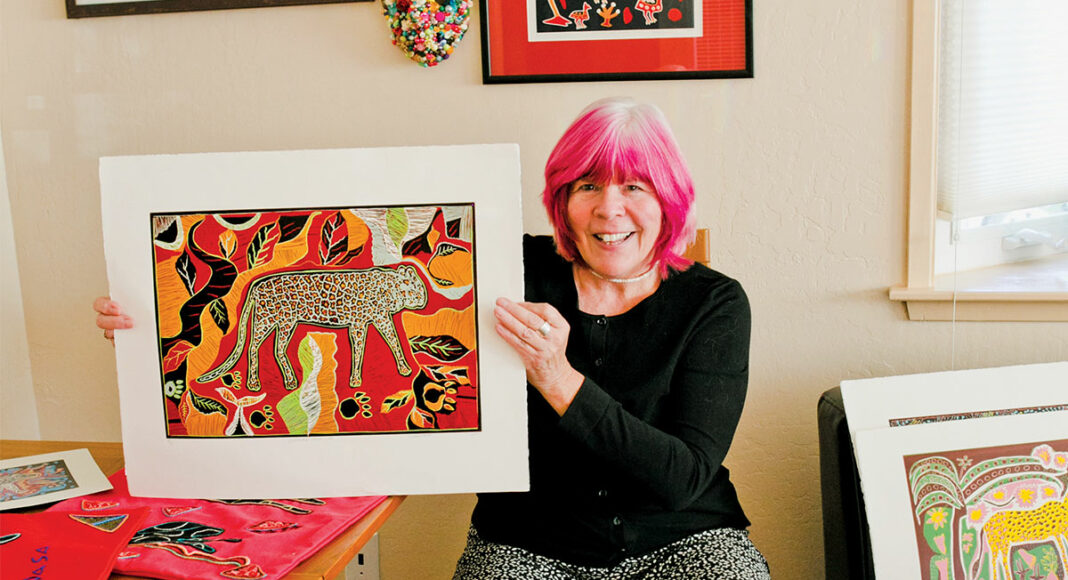Santa Cruz resident Peggy Flynn is bringing three indigenous citizens of Botswana to the U.S. for the first time ever, and her list of concerns includes indigestion, weather and goats.
“They seemed sad when I told them there are no goats,” she says. “They may be cold, so I told them I have robes that they can wear. But I realized they likely don’t know what a robe is.”
The San people are from the Kalahari desert in Botswana, a landlocked country in Southern Africa. They are what many refer to as Bushmen, and are hunter-gatherers acclimatized to temperatures over 100 degrees. Needless to say, Santa Cruz’s marine layer will take some getting used to.
With the help of many others, Flynn is bringing them here for an art auction at the Museum of Art and History (MAH) on Nov. 10. As part of the Peace Corps, she spent more than three years in Botswana with the San people. She learned about their history and culture, but was particularly moved by their artwork. In their village, there are around 16 artists that work regularly at an art collective. They are untrained, and use art as a means of income and to pass down their culture, history and folktales.
Their work can best be described as folk art, though it’s by no means typical. Jackals, elephants, and zebras dance across a canvas in a stunning overlap of vibrant colors and patterns depicting some of the most beautiful landscape and wildlife in the world.
“It’s a cultural exchange,” she says. “The value of the exchange is wherever we meet people from a different place, we get to meet and hopefully understand each other better.”
Though Flynn has a plethora of activities planned, including going to the Monterey Bay Aquarium and the redwoods, she brought the Batswana (the term for citizens of Botswana) artists to Santa Cruz first and foremost for the art auction. She plans on selling 15 paintings, 35 prints, three decorated plates and a Botswana safari trip for two. Several people have tried to coerce her into selling some pieces before the auction, including myself, but she won’t have it.
This will be the first time San art will be on exhibition in the U.S., says Flynn, though some artwork made a brief appearance on the tails of British Airways airplanes. Right now, her main concern is getting Ndodonyane Ditsheko, Xhoma Simon, and Jan John to Santa Cruz. Traveling through Heathrow Airport is a feat in itself, but imagine doing it without understanding English, never having been on an airplane, or knowing what a terminal is. The Bushmen speak Setswana, a clicking language, and see more zebras and lions than cars and buses. They will travel on a 17-hour flight to the U.S., and Flynn says they are the first Batswana people to travel to America.
“I just can’t imagine what they are going to think when they see the aquarium, when they see marine life,” she says, adding that they have never seen the ocean, let alone what’s in it. “I want to show them our diversity, even in this little place. I want to show them who we are.”
The Batswana art techniques are not being taught or passed on through the generations, and it’s predominantly the elderly who are painting. But once they die, painting techniques, heritage and history die with them. With this in mind, Flynn hosted art auctions in Botswana on behalf of the village. After hearing that the San teen pregnancy and dropout rate are the highest in the country, she planned the Santa Cruz auction to fund a year-long art workshop to support young San girls and continue the lineage of painting.
“The girls will sit with the elders, paint and learn about their stories in a supportive environment,” Flynn says. “A nurse will be there and can give them a safe place to talk about their challenges.”
The San people are believed to be humanity’s ancestors, the first Homo sapiens dating back more than 30,000 years ago. But they live in poverty and are often identified by racial and cultural stereotypes perpetrated by commercial media and in movies like The Gods Must Be Crazy, and based on outdated assumptions and generalizations of indigenous African people.
In bringing them here, Flynn hopes to dispel assumptions about them and their lifestyle, while also giving back to her ancestors and the people that welcomed and gave her so much—including her Batswana dog, Cocoa Puff, who lives with her in their westside home.
“These people, even though they are an ancient tribe, are not a stereotyped group living in leather loincloths,” Flynn says. “The best way to show that is to see the art and meet them.”
The auction will be at the MAH from 5-8 p.m. on Friday, Nov. 10. Tickets are $50, including food and beverages, and are available at the door or online at tinyurl.com/artsaveslives. For more information on the project, visit kalaharisan.org.














